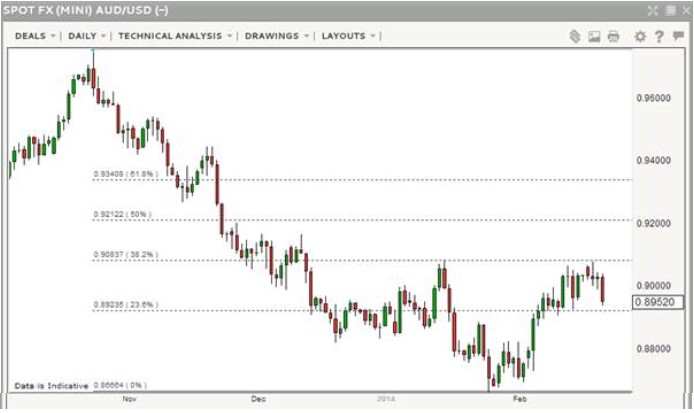
Risk turned sour in Asia as investors reacted to the disappointing China HSBC manufacturing PMI reading for February. The reading came in at 48.3 which was well below expectations of a flat 49.5. This was a seven-month low for this reading and the employment sub-index came in at 46.9, its lowest level since February 2009. New orders and production fell sharply, while new export orders were marginally higher. This move deeper into contractionary territory is not what the market wanted to see at a time when sentiment is growing increasingly fragile.
We had already seen sentiment come off in US trade on the back of disappointing economic data and the Fed minutes. Unless there is a significant shift in conditions, the Fed is likely to continue tapering at a pace of $10 billion a month. A key discussion was around the unemployment rate approaching the 6.5% threshold and what this means for rates. With the unemployment rate falling to 6.6%, this really puts the notion that rates will not be raised until at least 2015 into question. As a result the FOMC is preparing to amend its forward guidance on when it might begin to raise rates.
With members split between providing quantitative or qualitative guidance, I wouldn’t be surprised to see a switch to a mix of the two. It is hard to see rates being raised while inflation remains well below target. It’s worth bearing in mind that the Fed funds future is still only pricing in 59 basis points of hikes from the Fed by December 2015, which is sixteen basis points below the Fed’s own consensus.
Equities struggling in Asia
Regional equities are feeling the pressure from the disappointing China data along with a miss on the Japan front as well. The ASX 200 reversed sharply from a healthy gain while the Nikkei, Hang Seng and Shanghai Composite are all trading lower. Japan’s trade balance came in wider than expected, with a sharp drop in exports, while imports rose. This was quite surprising given the weaker yen would have been expected to underpin exports. However, the weekly fund flows data showed a positive swing in Japan buying foreign bonds and stocks, while foreign buying of Japan bonds and stocks dropped.
Aussie dollar sold off
AUD/USD was perhaps the biggest hit on the back of the China data, plunging through 0.90 which had held over the past couple of sessions. The pair dropped to a low of 0.8947 where it has since found some stability but still looks incredibly vulnerable. After failing at the January highs in the 0.908 region twice this week, a near-term reversal now seems to be in play. Near-term support is likely to be in the 0.89 region. There is nothing on the Australian economic calendar for the rest of the week to look out for and therefore focus will shift to the USD side of the equation.
On the US economic calendar we have CPI, unemployment claims and flash manufacturing PMI data due out along with the Philly Fed manufacturing index which will give a bit more insight into the weather impact. On the CPI front the market is looking for a 0.1% rise; any upside risk to this will only support the USD further and potentially weigh on risk. Meanwhile comments by Fed members remain mixed, with James Bullard saying he’d favour dropping explicit thresholds and reverting back to just looking at data.
(AUD slips on China data)
Reporting companies outperform in Australia
Looking ahead to the European session, we are calling the major bourses weaker. Focus will be on a raft of PMI readings for the region on both the manufacturing and services front. Most of the PMI readings are expected to show some signs of improvement, which leaves the single currency vulnerable to any negative surprises. The euro has actually held up fairly well despite the subdued risk tone. Apart from PMIs we also have German PPI and French CPI due out.
The Australian market actually had a fairly positive day on the earnings front with solid gains for reporting companies like Adelaide Brighton, Fairfax, AMP and Leighton Holdings. Just taking a look at how reporting season has turned out so far, 61% of ASX 200 listed companies have reported. Out of those, about 47% have surprised to the upside on the sales front, while 50% have surprised to the upside on earnings. While this seems average at best, the majors did well earnings wise and really helped underpin the rest of the market. With most of the big names out of the way, reporting will now be winding down with focus shifting to broker ratings changes. Reporting tomorrow we have Santos, IAG, Iluka and MMS being the main ones.
